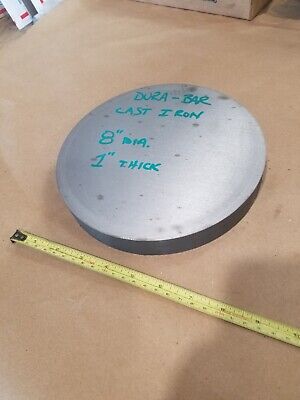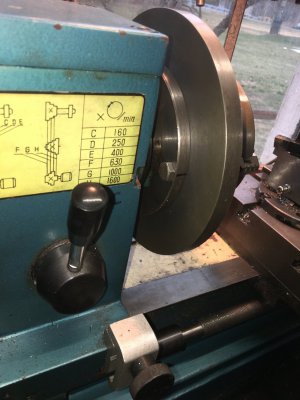yes , but not at that price LOL ...You need something like this.

Dura bar, Cast Iron, Round Disc, 8" dia x 1" thick, Machine, Lathe Stock | eBay
Cast Iron Round Disc.www.ebay.com
-
Welcome back Guest! Did you know you can mentor other members here at H-M? If not, please check out our Relaunch of Hobby Machinist Mentoring Program!
You are using an out of date browser. It may not display this or other websites correctly.
You should upgrade or use an alternative browser.
You should upgrade or use an alternative browser.
Transfering/ laying out holes for adapter plate.
- Thread starter mac1911
- Start date
not so much concerned , I need to learn. I really dont have any tools to do the lay out. My one drafting compass is a small desk type to 3" 6" machinist pocket ruler a digital caliper and a 1 - 4" set of micrometers. I picking stuff up as I find it for short money. Like the chuck.I see that you're in MA. If you're concerned about measuring: I might have time to assist if you want to bring both the original and new chuck over. Do you have other concerns, such as ability to machine the hole pattern, machining all features accurately, ...?
Not trying to dissuade you from learning a layout approach - projects (and their failures) are a great way of learning. Folks have shared some tips to try to keep some costs down. But time is certainly one cost you won't save on and therecanwill be accidental costs which could add up to more than just opening up your wallet.
And now seeing with your comment about the material needed - if the $70-ish for the material is a concern: it sounds like sell & buy a turn-key 4j may be your preference for this project.
I dont even know the limits of my machine yet, smithy 1220. So at the moment it looks like I need to buy some lay out tools ( need them anyway)
Some material - which has become harder to find useful scrap. New/Raw material approaches the cost of just buying the parts for the level this lathe needs ?
- Joined
- Jun 10, 2019
- Messages
- 534
I've measured and laid out hole patterns with just a set of digital calipers and bolts/pins in the holes...nothing more. A set of dividers (link) would be a bit handier, but for what it is I think you can get away with the tools you have as long as you're careful. What else do you think you need?
After you determine PCD from the chucks: use some hardboard (very cheap) and practice your layout there. Center punch & drill: see if it lines up w/ your chuck. If going thru that exercise is frustrating or has multiple fails: then you know the route to go!
Question for others: I realize cast iron would be preferred, but for Mac's application would mild or alloy steel really make that much practical difference? Would be quite a bit less $. link
After you determine PCD from the chucks: use some hardboard (very cheap) and practice your layout there. Center punch & drill: see if it lines up w/ your chuck. If going thru that exercise is frustrating or has multiple fails: then you know the route to go!
Question for others: I realize cast iron would be preferred, but for Mac's application would mild or alloy steel really make that much practical difference? Would be quite a bit less $. link
I have no idea what I need, lolI've measured and laid out hole patterns with just a set of digital calipers and bolts/pins in the holes...nothing more. A set of dividers (link) would be a bit handier, but for what it is I think you can get away with the tools you have as long as you're careful. What else do you think you need?
After you determine PCD from the chucks: use some hardboard (very cheap) and practice your layout there. Center punch & drill: see if it lines up w/ your chuck. If going thru that exercise is frustrating or has multiple fails: then you know the route to go!
Question for others: I realize cast iron would be preferred, but for Mac's application would mild or alloy steel really make that much practical difference? Would be quite a bit less $. link
I have accumulated a bunch of stuff here and there. I cant even get at me lathe at the moment and with the cold creeping back in it will be a few more weeks before the warm up.
I have played with hot rolled stock and it does not play well
I might have access to aluminum? I know its not ideal but for what I do it might be fine.
- Joined
- Jan 30, 2017
- Messages
- 261
These are representations of exact methods for patterning holes on a circle. A rotary table is the easy way to machine the part, but you can map out the cartesian coordinates of each hole and just work it out on your mill table with a drill. You can find as many digits past the decimal you need, find center, and go to town.
View attachment 438770View attachment 438767
That looks like chinese algebra to me.
That looks like chinese algebra to me.
YesDoes your chuck mounting bolts and area on the headstock look like this ?
- Joined
- Apr 23, 2018
- Messages
- 6,561
If you can understand the spirograph, then you can run one of these. My dad's tool and die making uncle used to map out the trigonometry (with stopwatch time stamps) using his slide rule (which is in my Kennedy chest, but skills didn't come with it) for the movements on universals like this in a notebook, one step at a time, before ever making a cut. Now ask yourself if computers are a crutch!
- Joined
- Apr 16, 2019
- Messages
- 745
Since you said it’s similar, once the backplate had the correct locating shoulder I used a C clamp to hold it in place on the spindle , used a short round stock with a machined point to act as a transfer punch , you just need it long enough to stick out the spindle so a brass punch on an angle can give it a tap to make a small mark on the backplate . , made one mark , removed it , drilled and taped just that one , used the first finished hole to bolt the backplate on , mark the next , repeat 2 more times . There’s plenty of clearance in the spindle holes , the fit between the spindle and backplate locating shoulder is the critical dimension


